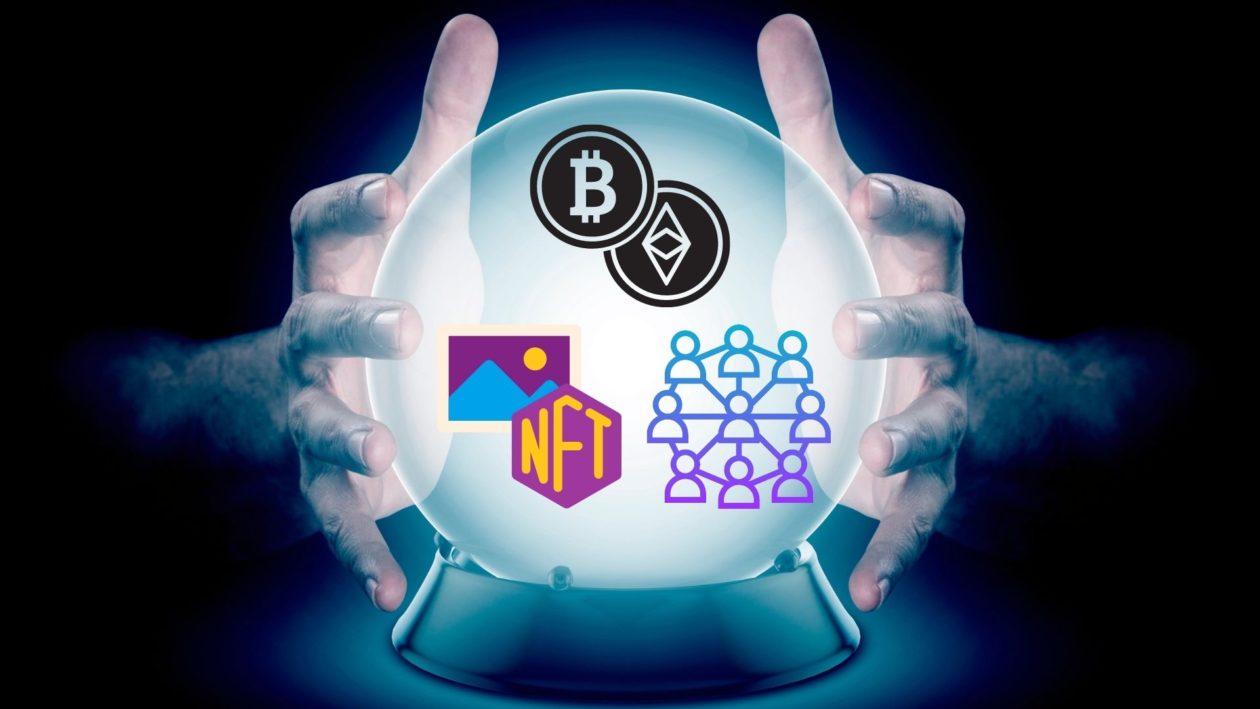Blockchain and cryptocurrencies came into their own in 2021, with the total market cap of cryptocurrencies crossing the US$2 trillion mark and traditional companies such as Microstrategy, PayPal and Tesla making major moves into crypto. The prices of cryptocurrencies hit all-time highs, as the number of crypto users surged.
As 2021 draws to a close, Forkast.News consulted crypto industry leaders on some of the major milestones this year and the key themes and trends to watch in the year ahead.
1. DeFi going mainstream — with regulators to follow
Crypto adoption soared in 2021 with the number of crypto users doubling in the first half of the year and institutional investors adding cryptocurrencies such as Bitcoin and Ethereum to their balance sheets. The launch of the much-anticipated Bitcoin Futures ETFs in the United States was seen as a watershed moment for the industry, providing legitimacy — and the assurance — that the asset class is here to stay.
Decentralized finance (DeFi), which took off in the so-called “DeFi summer” of 2020, continued its skyrocketing trajectory this year. DeFi — where users can perform financial transactions directly with one another using smart contracts without the need for intermediaries — has the potential to bring economic and social benefits to the world’s unbanked by allowing them to have savings accounts and obtain loans that would otherwise be out of reach to them.
The DeFi industry is still in its infancy, but a wide array of financial services from asset management, yield farming or borrowing and lending, decentralized exchanges, derivatives, and stablecoins — on the blockchain have flourished in 2021, increasing from US$22 billion at the start of the year to over US$250 billion now locked across DeFi protocols, according to DeFi Llama data.
See related article: Why Thailand’s oldest bank is investing US$110 million in DeFi
Alongside DeFi’s growing popularity, fraud and thefts across DeFi platforms have also soared, rising 600% from US$1.5 billion in 2020 to over US$10.5 billion this year, according to Elliptic, a blockchain data analytics firm.
Regulators are still grappling with how to deal with DeFi, especially since there may not be a clearly identifiable intermediary to regulate in a truly decentralized protocol operating on smart contracts.
“Regulators that take an active role in shaping regimes to accommodate new technologies will likely be a positive force in establishing their markets as hubs for secure DeFi activity, globally, and helping to reduce rates of crime,” Chris DePow, Elliptic’s senior adviser for financial institution regulation and compliance, told Forkast.News.
Danny Chong, co-founder and CEO of Tranchess, a yield-enhancing asset tracker, expects more definitive standards to be observed across borders as financial institutions increasingly venture into crypto. “This will ultimately make DeFi more mainstream friendly and allow more possibilities for DeFi to evolve,” Chong told Forkast.News. “In turn, we will see a rise in TradFi institutions adopting crypto, along with new protocols, chains, layer-2 scaling solutions and tech upgrades.”
Chong expects the convergence of traditional finance with crypto to accelerate via investments and mergers and acquisitions, and crypto firms reaching out to a mainstream audience through sponsorship deals.
See related article: How DeFi, NFTs and DAOs are building a value exchange layer for Web 3.0
2. NFT use cases expand as the metaverse builds out
2021 has been a banner year for non-fugible tokens (NFTs). US$69 million — that was the eyewatering amount that an NFT artwork by digital artist Beeple titled “Everydays: The First 5000 Days” sold for in a Christie’s auction in March. NFT sales this year to date, as of the first week of December, amounted to over US$11.8 billion, an increase of a whopping 17,700% compared to 2020, according to Nonfungible.com.
Opensea, the world’s biggest NFT marketplace, crossed the US$10 billion mark in cumulative trading volume in November. Payments giant Visa to McDonald’s China are among the many brands and companies that have jumped onto the NFT bandwagon.
Helen Hai, head of Binance NFT, sees NFTs as an asset class and tool for engaging fans and collectors and adoption will get a huge boost next year, and the trend for NFT avatars (PFP profile picture collections) will continue.
See related article: Riding the NFT trend: questions to consider before investing in these hot digital assets
Beyond art and collectibles, play-to-earn blockchain games such as Axie Infinity and Alien Worlds exploded in popularity. Playing Axie Infinity and breeding cute Axies went from being a fun pastime during pandemic lockdown to a source of income for gamers, in particular those in the Philippines.
NFTs, DeFi and play-to-earn gaming are also converging. Binance in October launched its new Initial Game Offering (IGO) arm for customers to invest in gaming NFTs projects. With the rise of “GameFi,” Hai predicts that traditional free-to-play developers will go into blockchain games. “This game genre will not be driven by crypto native developers anymore but we will see big developers/publishers enter the space by the end of next year,” Hai said.
Hai predicts that traditional markets such as music, ticketing, entertainment will be disrupted by NFTs in the coming year, including the possibility of revenue participation via smart contracts that involves all constituents of a value chain such as composers, artists, musicians, producers and collectors. Although NFTs, for now, are mainly static images, Hai expects to see dynamic NFTs being integrated with real-world events such as weather data or stock data. “Any real-world data can flow into NFTs and can have an impact on the NFT itself,” Hai said, in an email to Forkast.News.
Rachel Mayers, VP of product at Circle, agrees that the use cases for NFTs will only continue to explode: “Brands and creators just reinforcing loyalty community behavior in terms of rewarding NFTs, distributing content, making a purchase, everything will be an NFT next year.”
Zach Burks, CEO and founder of NFT marketplace Mintable, predicts that layer-2 solutions such as Immutable X, an NFT scaling platform on Ethereum, will open up a lot of activity for NFTs. “You’re going to see a lot more NFTs in your daily life, and these are going to be coming from brands. Big brands will be exploring with NFTs in some way, shape or form,” said Burks, in an interview with Forkast.News. “It’s this flywheel of new people coming on board, buying ETH, ETH being deflationary, and then we start a bull run and then more people come on board, and then it’ll top out, and then we go into a bear market.”
The metaverse is also a key theme as a head into 2022. Facebook’s corporate rebranding to “Meta” and plans to go big on the metaverse as a virtual social platform brought the word into the mainstream and sent the prices of tokens of decentralized metaverses built on the blockchain such as Decentraland and The Sandbox soaring.
Yat Siu, executive chairman and co-founder of Animoca Brands, envisions the future of the metaverse as an open one built on the concept of actual true digital ownership, comprising many blockchains — layer 1s and 2s — with interoperability through bridges. The metaverse is still at the early adopter stage, and Siu expects massive growth from the millions of users today to hundreds of millions.
Skirmantas Januškas, CEO and co-founder of DappRadar, told Forkast.News in an email: “2020 was ‘The Year of DeFi,’ 2021 was ‘The Year of NFTs,’ with gaming arguably stealing its spotlight over the last quarter. As these three categories converge, 2022 will undoubtedly be ‘The Year of the Metaverse,’ with the platforms supporting and helping navigate this complex, cross-chain and cross-category paradigm coming to the fore.”
3. Rise of the DAOs — and how they are changing the way we live, work and engage
DAOs, short for decentralized autonomous organizations, have emerged as an organizational structure to manage tokenized assets, fundraise and facilitate transparent governance. “DAOs are likely to have an enormous impact on the adoption of Web3 products,” wrote Carra Wu and Chris Dixon from venture capital firm a16z in a recent blog post.
DAOs have been touted as an alternative governance mechanism to the traditional board structure in companies and a new way for crypto companies to go public. Many DeFi applications, such as Uniswap, Aave and MakerDAO, are governed by DAOs, which provide a mechanism for protocol development and treasury management through self-executing smart contracts on the blockchain. There is currently US$13 billion in assets under management in DAOs, according to DeepDAO data.
In the United States, Wyoming passed legislation earlier this year to give DAOs legal status as limited liability companies (LLCs). The state is home to CityDAO, a company organized as a DAO with the mission of creating blockchain cities in the real world. The CityDAO team has bought a 40-acre parcel of land in a far-off corner of Wyoming and plans to buy more property in the future. Each parcel of land is an NFT that can be owned collectively by the DAO collectively or by individuals.
See related article: Vitalik Buterin imagines a future of crypto cities
DAOs have also been formed for investing purposes. BitDAO, which touts itself as one of the biggest DAOs in the world, was formed to invest in DeFi. It completed a US$230 million private sale led by Peter Thiel, Founders Fund, Pantera Capital and Dragonfly Capital earlier this year and the BitDAO treasury currently has over US$3 billion worth of crypto assets, according to the BitDAO website.
PleasrDAO was formed earlier this year by a group of DeFi leaders, NFT collectors and digital artists to buy digital artist Pplpleasr’s Uniswap V3 NFT. The DAO has since gone on to acquire more digital artworks and in July obtained a US$3.5 million loan with C.R.E.A.M. Finance’s Iron Bank using some of its high-value NFTs as collateral.
More recently, ConstitutionDAO came together to try to buy the last privately-owned, first-edition copy of the U.S. Constitution at a Sotheby’s auction in November. It failed in its attempt and suffered a chaotic aftermath, but its formation propelled DAOs into mainstream news headlines and public consciousness.
Spencer Graham, Product Manager of DAOhaus, a no-code platform for launching and servicing DAOs, expects the DAO landscape to mature in terms of more well-defined segments or types of DAOs, along with different types of DAO tooling focused on supporting each.
“More DAOs will be able to use on-chain voting as layer 2s like Arbitrum, Optimism, ZKsync, and Starknet offer cheaper gas costs,” Graham told Forkast.News. “That will create opportunities for many more DAOs to form without relying on multisig executive councils, lowering the barriers for more people to pool their assets within DAOs.”
Specific purpose and identity-based DAOs driven by the values and interests of their community are only going to become more common, as will collaboration between DAOs. “We see a world where DAOs will own a piece of each other and the DAO movement will itself become too big to fail, but with vastly better (and more equitable) impact,” said Namik Muduroglu, ecosystem coordinator at PrimeDAO, in an email to Forkast.News.
“DAOs will gain traction in real-world use cases, ranging from collectives working in unison towards decentralizing intellectual property in an open and democratic manner (VitaDAO), hobbyists coordinating trips and events (i.e GnarCollective), to organizations and identities that choose to unify around a particular cause ( i.e VoizDAO),” Muduroglu predicted.
More tools for DAOs is expected to be a major growth area in 2022. “It is when DAOs have reached a stage of maturity where scalability problems lie. Here, DAO tooling, spearheaded by DAO-to-DAO (D2D) collaboration, will shine,” Muduroglu said. “D2D collaboration will allow all stakeholders involved to participate and prosper using trustless, on-chain primitives that align with Web3 values.”
For more expert insights into what lies ahead for cryptocurrencies and blockchain, check out Forkast Forecasts — a special series featuring the reflections on this year and predictions for 2022 from the industry’s visionaries, leaders and thinkers.





